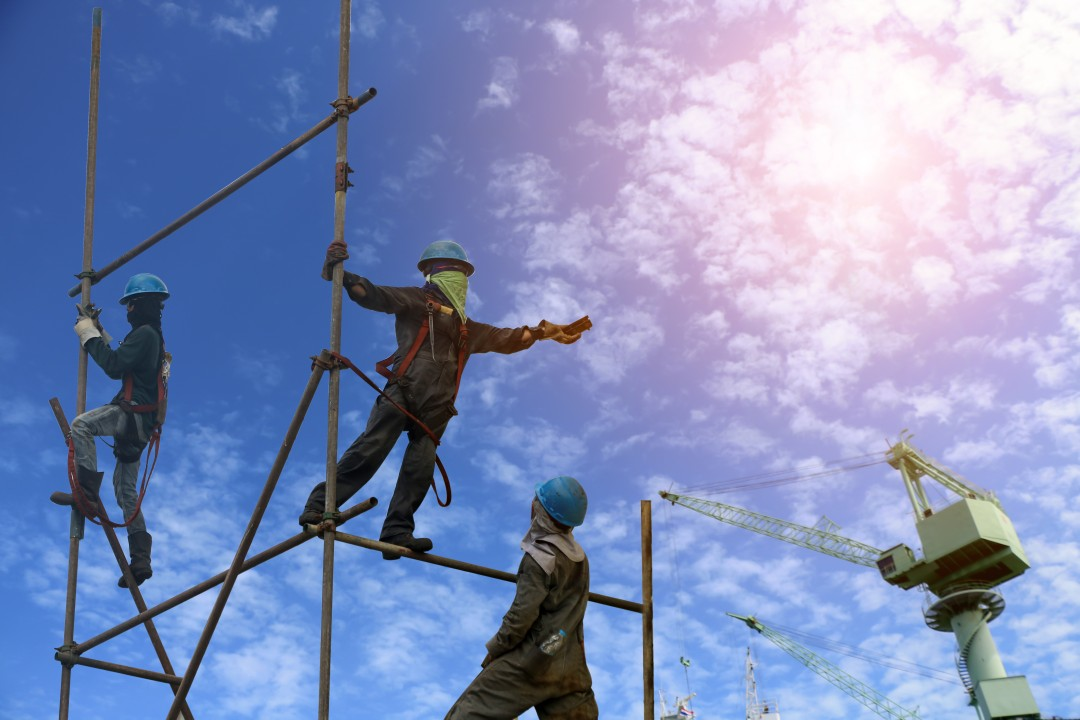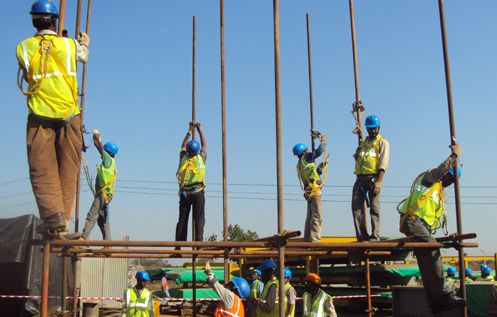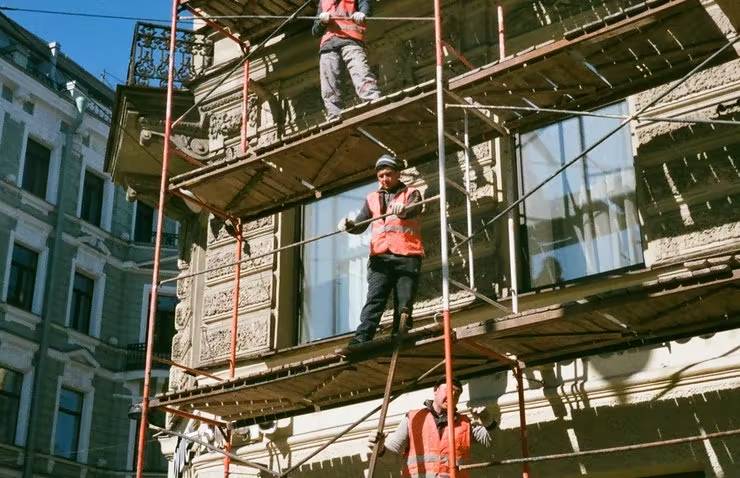Rigger Piling (6 month course)
Rigger Piling click here
Brief Job Description: The job role is responsible for assisting in conventional cast insitute piling works by erecting piling tripods, shifting required materials/ components and
carrying out various activities as applicable to piling works.

Personal Attributes: The individual is expected to be physically fit and should be able to
work across various locations especially in marshy/ muddy locations. The individual
should be able to implement and maintain safety practices. The individual should have
good communication skills and shall be able to work within a team to handle various
rigging tools and materials as applicable to conventional bored piling works.
Description
Sector Sector is conglomeration of different business operations having similar
business and interests. It may also be defined as a distinct subset of the
economy whose components share similar characteristics and interests.
Sub‐Sector Sub‐Sector is derived from a further breakdown based on the characteristics
and interests of its components
Occupation Occupation is a set of job roles, which perform similar/related set of
functions in an industry
Job role Job role defines a unique set of functions that together form a unique
employment opportunity in an organization.
Occupational Standards
(OS)
OS specify the standards of performance an individual must achieve when
carrying out a function in the workplace, together with the knowledge and
understanding they need to meet the standard consistently. Occupational
Standards are applicable both in the Indian contexts.
Performance Criteria Performance Criteria are statements that together specify the standard of
performance required when carrying out a task.
Qualifications Pack (QP) Qualifications Pack comprises the set of OS, together with the educational,
training and other criteria required to perform a job role. A Qualification Pack
is assigned a unique qualification pack code
Qualification Pack Code Qualification Pack Code is a unique reference code that identifies a
qualifications pack.
National Occupational
Standards (NOS) NOS are Occupational Standards which apply uniquely in the Indian context.
Scope Scope is the set of statements specifying the range of variables that an
individual may have to deal with in carrying out the function which have a
critical impact on the quality of performance required.
Knowledge and Understanding
Knowledge and Understanding are statements which together specify the
technical, generic, professional and organizational specific knowledge that an
individual needs in order to perform to the required standard.
Organizational Context Organizational Context includes the way the organization is structured and
how it operates, including the extent of operative knowledge managers have of their relevant areas of responsibility.
Technical Knowledge Technical Knowledge is the specific knowledge needed to accomplish specific
designated responsibilities.
Core Skills / Generic Skills Core Skills or Generic Skills are a group of skills that are key to learning and
working in today’s world. These skills are typically needed in any work environment. In the context of the OS, these include communication related skills that are applicable to most job roles.
Keywords /Terms Description
CON Construction
NSQF National Skill Qualifications Framework
QP Qualification Pack
OS Occupational Standards
TBD To Be Decided
Assemble materials, equipment’s for bored cast in-situ concrete piling work
Description This unit describes the skills and knowledge required to assemble materials,
equipment’s for bored cast in-situ concrete piling work
Scope The scope covers the following:
Assemble and erect piling tripod at specified location
Shift materials, install pumps, pipelines to facilitate pile boring works
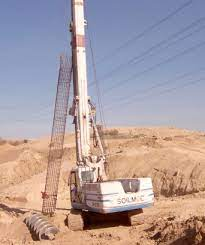
Performance Criteria (PC) w.r.t. the Scope
Element Performance Criteria
Assemble and erect piling tripod at specified location
To be competent, the user / individual on the job must be able to:
PC1. check for safe condition and cleanliness of rigging gears, components and
tools to be used for assembling piling tripod
PC2. shift and stack required rigging gears, tripod components at specified
location prior to erection of tripod as per instruction
PC3. assemble, erect and set up tripod of desired height using specified
components at specified location of boring
PC4. carry out necessary linear measurement to the tripod to ensure its desired
dimensions and location, using appropriate measuring instrument
PC5. shift and assist in setting up winch at specified position
PC6. secure and lock the tripod in to its location by using suitable locking means as per instruction
PC7. install pulley and necessary rigging gears to the tripod and ensure their proper locking
PC8. carry out lubrication of rigging gears under operation end ensure their smooth working
PC9. install wire rope/ pulling cable of the winch through the tripod as per instruction
PC10. anchor boring chisel and lock properly using appropriate hand tools and rigging gears
Shift materials, install pumps, pipelines to facilitate pile boring works
PC11. check for access and safe condition of locations where pump to be set up or material to be stored
PC12.shift and install pump to the sedimentation tanks or other locations as per work requirement under close supervision
PC13.shift required materials for executing piling operations such as bentonite bags, tremie pipe segments, pile casing etc. and stack properly at specified location as per instruction
PC14.shift, handle and stack flexible pipelines/ hose (cloth, PVC, etc.) at appropriate locations
PC15. connect flexible pipelines to the pump and ensure tightness and lay them through proper routes per instruction
PC16. ensure tightness of pipe joints to ensure spillage of bentonite slurry pumped from tank
PC17. expose pipelines to the specified locations (bore hole, sedimentation tank etc.) as per instruction
PC18.maintain proper housekeeping at work locations
Knowledge and Understanding (K)
A. Organizational Context (Knowledge of the company / organization and its processes)
The user/individual on the job needs to know and understand:
KA1. standard procedure for construction rigging works
KA2. safety rules and regulation for handling and storing relevant rigging tools,
equipment and materials
KA3. personal protection including the use of relevant safety gears & equipment’s
KA4. service request procedures for tools, materials and equipment’s
B. Technical Knowledge
The user/individual on the job needs to know and understand:
KB1. basic principles of measurement, geometry and arithmetic calculation
KB2. conversion of units of linear measurements
KB3. units of measurements
KB4. use of various material components used in bored cast in situ concrete piling work
KB5. selection and use of hand tools for erection of tripod and piling work
KB6. sequence of several activities of bored cast in situ concrete piling operations
KB7. assembling procedure and suitable adjustments to be made in piling tripod
KB8. procedure of shifting and setting up winch at specified location
KB9. selection and use of rigging gears at piling tripod
KB10.setting up pumps and hoses to route water and bentonite
KB11. installation techniques for piles
KB12. procedure for carrying out splicing and jointing works
KB13. basic concept of types of soil, sand, rock, clay, shale, gravel and silt types
and characteristics
Skills (S)
A. Core Skills/ Generic Skills Writing Skills
The user/ individual on the job needs to know and understand how to:
SA1. write in one or more language, preferably in the local language of the site
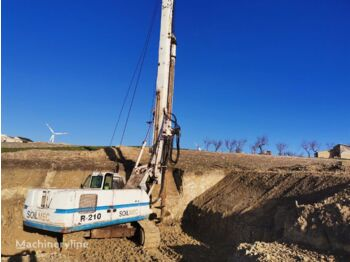
Reading Skills
The user/ individual on the job needs to know and understand how to:
SA2. read one or more language, preferably in the local language of the site
SA3. read various, sign boards, safety rules and safety tags , instructions related
to exit routes during emergency at the workplace
Oral Communication (Listening and Speaking skills)
The user/ individual on the job needs to know and understand how to:
SA4. speak in one or more language, preferably in one of the local language of the site
SA5. listen and follow instructions given by the superior
SA6. orally communicate with co-workers regarding support required to complete the respective work
B. Professional Skills
Decision Making
The user/individual on the job needs to know and understand how to:
SB1. decide whether his workplace is safe for working and also his work is not
creating hazardous conditions for other
SB2. decide whether the rigging gears, components and tools are clean and safe
to be used for assembling piling tripod
Plan and Organize
The user/individual on the job needs to know and understand how to:
SB3. plan work and organize required resource in coordination with team
member and superior
Customer centricity
The user/individual on the job needs to know and understand how to:
SB4. complete work as per agreed time and quality
Problem solving
The user/individual on the job needs to know and understand how to:
SB5. ensure tightness of pipe joints to ensure spillage of bentonite slurry pumped from tank
SB6. resolve any conflict within the team
Analytical Thinking
The user/ individual on the job needs to know and understand how to:
SB7. calculate the appropriate quantity of required materials as per applicability
SB8. carry out necessary linear measurement to the tripod to ensure its desired dimensions and location
SB9. optimize resources
SB10. minimize wastages
SB11. revert to superior for selection/sorting of materials
Critical Thinking
The user/individual on the job needs to know and understand how to:
SB12. evaluate the complexity of the tasks to and seek assistance and support
wherever required from the superior
SB13. identify and assess how violation of any safety norms may lead to accidents
Assist in conventional bored cast in situ concrete piling work
Description This unit describes the skills and knowledge required to assist in conventional bored
cast in situ concrete piling work.
Scope The scope covers the following:
Assist in boring activity
Carry out flushing of borehole using bentonite slurry
Shift stack reinforcement cages and lower them in to the borehole
Carry out pile concreting work
Performance Criteria (PC) w.r.t. the Scope
Element Performance Criteria
Assist in boring activity
To be competent, the user / individual on the job must be able to:
PC1. shift/ adjust the location of casing pipe to ensure proceeding of drilling at
exact pile location within specified limit of tolerance
PC2. spread bentonite powder in tank consisting water in order to obtain slurry
under supervision
PC3. cut channel from borehole to the sedimentation tanks in order to route
overflowed slurry with bored mud/soil etc.
PC4. erect barrication, signage as per work safety requirement surrounding the
piling location such as piling tripod, bentonite tank etc.
PC5. lower temporary guide casing in to bored hole during initial boring as per
instruction
PC6. ensure vertical alignment of the casing and lock it in to its position by
suitable means
PC7. carry out necessary measurements from given reference survey points to
ensure position of casing pipe
PC8. monitor boring of pile by using chisel or rotary augers up to the specified
depth
PC9. ensure circulation of bentonite slurry using reciprocating pumps/ vertical
pumps into the bore hole and from bore hole to the sedimentation tank
PC10. facilitate lowering of reinforcement steel cage in to the borehole by crane/
manually
PC11. carry out flushing activity in order to remove loose material out of the pit
PC12. monitor concreting work maintaining all standard practices
Carry out flushing of
borehole using
bentonite slurry

PC13. lower tremie pipes of specified diameter by joining them one after another
in to the borehole under close supervision
PC14. lock/ support the pipe assembly by suitable means using appropriate hand
tools as per instruction
PC15. ensure minimum clearance has been maintained between bottom of the tremie pipe and pile base
PC16. attach tremie head to the top of the pipe assembly and lock it properly
PC17. flush the bore by pumping bentonite slurry and discharging through the pipe
assembly as per instruction
PC18. monitor inflow and outflow of bentonite slurry in order to ascertain
completion of flushing activity
PC19. carry out cleaning and housekeeping of the work location as per instruction
Shift stack
reinforcement cages
and lower them in to
the borehole
PC20.shift and stack prefabricated reinforcement steel cages at specified locations
using lifting equipment’s
PC21. place sleepers, blocks, pegs under the steel cages to hold them in to their
positions against sliding
PC22. perform checks to the rigging gears and hand tools to ensure their safe
working prior to using it lifting activity
PC23. use appropriate PPEs, rigging gears during lifting, shifting and lowering cages
using load lifting equipment’s
PC24. check and ensure physical conditions of the cages are as per quality
requirement after stacking the cage
PC25. check for cover blocks, binding of reinforcement and report to concerned
person if any deviation observed
PC26. handle, control movement and position of suspended cages prior and during
lowering in to pile borehole
PC27. lower the cages in to the borehole and required bracings, supports to hold
them in to position under close supervision in case of spot welding is
required for joining/ extending them
PC28. carry out required measurement to the cage to ensure that they have
reached to the bottom the borehole
Carry out pile concreting work
PC29. attach concreting hopper/ funnel to the tremie pipe and lock it properly at
the position prior to start concreting
PC30. pour adequate concrete to the hopper ensuring water tightness of the whole assembly
PC31. confirm that the tremie pipe is adequately inserted in to the bed of concrete
PC32.remove tremie pipe one by one starting from the top as the level of concrete rises upward
PC33. communicate with concerned personnel, vehicle/ winch operator to achieve smooth working
PC34. continue concreting up to the required level as per instruction and ensure
continuous agitation of the whole pipe assembly throughout the concreting procedure
PC35. ensure cleaning and greasing of tremie pipe segments, funnel etc. those are
used for pile concreting work post concreting activity
Knowledge and Understanding (K)
A. Organizational
Context
(Knowledge of
the company /
organization and
its processes)
The user/individual on the job needs to know and understand:
KA1. standard procedure for construction rigging works
KA2. safety rules and regulation for handling and storing relevant rigging tools,
equipment and materials
KA3. personal protection including the use of relevant safety gears & equipments
KA4. service request procedures for tools, materials and equipments
B. Technical
Knowledge
The user/individual on the job needs to know and understand:
KB1. basic principles of measurement, geometry and arithmetic calculation
KB2. conversion of units of linear measurements
KB3. units of measurements
KB4. sequence of boring activity in piling operation
KB5. equipment’s, tools and rigging gears required for piling operations
KB6. how to align guide casing in to specified position
KB7. how to measure alignment using measuring instruments
KB8. standard practice of storing and stacking materials, tools, equipments and \
accessories used in bored cast in situ piling operation
KB9. brief concept of flushing work involved in bore piling and its importance
KB10. physical properties of bentonite powder and its use in boring /flushing
activities
KB11. checks to be carried out in prefabricated reinforcement steel cages
KB12. material handling procedures while working with lifting equipment’s
KB13.safe technique and use of tools for locking reinforcement cages in its
position in case of welded joints used for extending the cage
KB14. checks to be done during lowering of reinforcement cages in to borehole
KB15.sequence and relevance of flushing activity in piling operations
KB16. how to join and lock tremie pipes using hand tools
KB17. minimum clearance to be kept from bottom of tremie pipe and base of pile
KB18. functions of different kinds of pumps used in piling operation
KB19. consistency of bentonite slurry to be maintained during piling work
KB20. minimum quantity of concrete to be kept in the hopper/ funnel to make the
assembly water tight
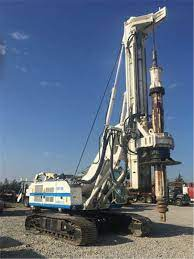
KB21. flowability/ workability of concrete to be used for pile construction
KB22. how to continue concreting work by repetitive lifting and lowering of tremie pipe assembly
KB23. basic procedure of hand signaling during working with heavy equipments
Skills (S)
A. Core Skills/ Generic Skills Writing Skills
The user/ individual on the job needs to know and understand how to:
SA1. write in one or more language, preferably in the local language of the site
Reading Skills
The user/ individual on the job needs to know and understand how to:
SA2. read one or more language, preferably in the local language of the site
SA3. read various, sign boards, safety rules and safety tags , instructions related to
exit routes during emergency at the workplace
Oral Communication (Listening and Speaking skills)
The user/ individual on the job needs to know and understand how to:
SA4. speak in one or more language, preferably in one of the local language of the
site
SA5. listen and follow instructions given by the superior
SA6. orally communicate with co-workers regarding support required to complete
the respective work
B. Professional
Skills
Decision Making
The user/individual on the job needs to know and understand how to:
SB1. decide whether his workplace is safe for working and also his work is not
creating hazardous conditions for other
SB2. decide whether the preparatory work is completed prior to piling works
Plan and Organize
The user/individual on the job needs to know and understand how to:
SB3. plan work and organize required resource in coordination with team
member and superior
Customer centricity
The user/individual on the job needs to know and understand how to:
SB4. complete work as per agreed time and quality
Problem solving
The user/individual on the job needs to know and understand how to:
SB5. make suitable adjustments for vertical alignment of casing
SB6. resolve any conflict within the team
Analytical Thinking
The user/ individual on the job needs to know and understand how to:
SB7. calculate the appropriate quantity of required materials as per
applicability
SB8. optimize resources
SB9. minimize wastages
SB10. revert to superior for selection/sorting of materials
Critical Thinking
The user/individual on the job needs to know and understand how to:
SB11. evaluate the complexity of the tasks to and seek assistance and support
wherever required from the superior
SB12. identify and assess how violation of any safety norms may lead to accident
Break RCC piles above cut-off level using pneumatic hammers
Description This unit describes the skills and knowledge required to break RCC piles above cutoff level using pneumatic hammers
Scope The scope covers the following:
Carry out preparatory works prior to pile breaking
Operate jackhammer to break concrete
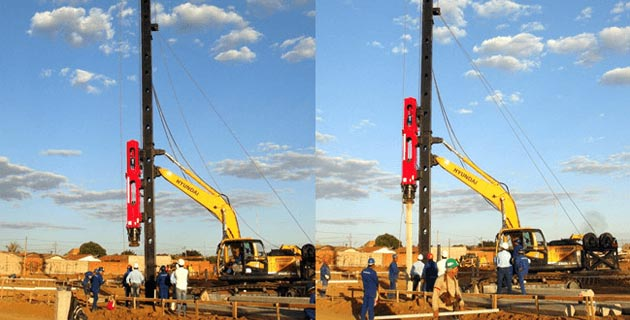
Performance Criteria (PC) w.r.t. the Scope
Element Performance Criteria
Carry out
preparatory works
prior to pile breaking
To be competent, the user / individual on the job must be able to:
PC1. check hose connecting hammer and air compressor for breaks, cracks prior
and during breaking activity and report to senior if such things observed
PC2. check jackhammer for its safe working condition and required lubrications
PC3. connect air compressor to the hammer using hose as per instruction
PC4. check and ensure tightness of accessories fitted with the jackhammer and
air compressor
PC5. check location of the pile to be broken for safe access
PC6. erect temporary working platforms as per work requirement
PC7. erect barricading, safety signage surrounding the work location as per
instruction
PC8. check for cut off level of pile and carry out necessary measurements from
provided reference level
Operate
jackhammer to
break concrete
PC9. lift and shift the jackhammer to the specified location
PC10. hold the jackhammer in to proper position in order to break concrete
PC11. press the jackhammer tightly against the pile concrete surface the trigger
the same to start breaking
PC12. break concrete up to specified level and ensure embedded reinforcement
bars do not get affected by hammer bit
PC13. changes hammer bit or add lengths as depth of breaking increases
PC14. carry out cleaning and lubrication of jackhammer as and when required
PC15. start and stop the compressor attached to the jackhammer prior and post
breaking activity
PC16. use applicable PPEs while breaking concrete by hammer
PC17. maintain proper body posture while shifting the hammer and breaking
concrete by the same
PC18. dismantle staging/ working platform, isolate jack hammer, hose and
compressor after completion of breaking activity and store them at specified
location
PC19. ensure cleaning of the location of pile after completion of work by disposing concrete debris to specified location
Knowledge and Understanding (K)
A. Organizational
Context
(Knowledge of
the company /
organization and
its processes)
The user/individual on the job needs to know and understand:
KA1. standard procedure for construction rigging works
KA2. safety rules and regulation for handling and storing relevant rigging tools,
equipment and materials
KA3. personal protection including the use of relevant safety gears & equipment’s
KA4. service request procedures for tools, materials and equipment’s
B. Technical
Knowledge
The user/individual on the job needs to know and understand:
KB1. how to handle jackhammer during concrete breaking activity
KB2. basic concept of pneumatic systems
KB3. process of erection of working platforms
KB4. process of attaching hose, jackhammer and air compressor machine
KB5. checks to be performed to the jackhammer assembly
KB6. selection and use of PPEs during concrete breaking activity
KB7. cut off level of pile
KB8. method of linear measurements using measuring instruments
KB9. body posture to be maintained while carrying out concrete breaking activity
KB10. basic maintenance (cleaning, lubrication etc.) to be undertaken to the
jackhammer
Skills (S)
A. Core Skills/
Generic Skills
Writing Skills
The user/ individual on the job needs to know and understand how to:
SA1. write in one or more language, preferably in the local language of the site
Reading Skills
The user/ individual on the job needs to know and understand how to:
SA2. read in one or more language, preferably in the local language of the site
SA3. read various, sign boards, safety rules and safety tags , instructions related
to exit routes during emergency at the workplace
Oral Communication (Listening and Speaking skills)
The user/ individual on the job needs to know and understand how to:
SA4. speak in one or more language, preferably in one of the local language of
the site
SA5. listen and follow instructions given by the superior
SA6. orally communicate with co-workers regarding support required to
complete the respective work
B. Professional
Skills
Decision Making
The user/individual on the job needs to know and understand how to:
SB1. decide whether his workplace is safe for working and also his work is not
creating hazardous conditions for other
SB2. decide whether the preparatory work is completed prior to pile breaking works
Plan and Organize
The user/individual on the job needs to know and understand how to:
SB3. plan work and organize required resource in coordination with team
members and superiors
Customer centricity
The user/individual on the job needs to know and understand how to:
SB4. complete work as per agreed time and quality
Problem solving
The user/individual on the job needs to know and understand how to:
SB5. ensure tightness of accessories fitted with the jackhammer and
air compressor
SB6. resolve any conflict within the team
Analytical Thinking
The user/ individual on the job needs to know and understand how to:
SB7. determine quantity of material required for piling works
SB8. optimize resources
SB9. minimize wastages
SB10. revert to superior for selection/sorting of materials
Critical Thinking
The user/individual on the job needs to know and understand how to:
SB11. evaluate the complexity of the tasks to determine if any guidance is required
from the superior
SB12. identify and assess how violation of safety norms may lead to accidents
Work effectively in a team to deliver desired results at the workplace
Description This unit describes the skills and knowledge required to work effectively within a
team to achieve the desired results.
Scope The scope covers the following:
Interact and communicate effectively with co-workers, superiors and subordinates across different teams
Support co-workers, superiors and sub-ordinates within the team and across
interfacing teams to ensure effective execution of assigned task
Performance Criteria (PC) w.r.t. the Scope
Element Performance Criteria Interact and communicate in effective and conclusive manner
To be competent, the user / individual on the job must be able to:
PC1. pass on work related information/ requirement clearly to the team members
PC2. inform co-workers and superiors about any kind of deviations from work
PC3. address the problems effectively and report if required to immediate
supervisor appropriately
PC4. receive instructions clearly from superiors and respond effectively on the same
PC5. communicate to team members/subordinates for appropriate work technique and method
PC6. seek clarification and advice as per the requirement and applicability
Support co-workers to execute project requirements
PC7. hand over the required material, tools tackles, equipment and work fronts
timely to interfacing teams
PC8. work together with co-workers in a synchronized manner
Knowledge and Understanding (K)
A. Organizational
Context
(Knowledge of
the company /
organization and
its processes)
The user/individual on the job needs to know and understand:
KA1. own roles and responsibilities
KA2. importance of effective communication and establishing strong working
relationships with co-workers
KA3. risks of a failure in teamwork in terms of effects on project outcomes,
timelines, safety at the construction site, etc.
KA4. different modes of communication, and its appropriate usage
KA5. importance of creating healthy and cooperative work environment among
the gangs of workers
B. Technical Knowledge
The user/individual on the job needs to know and understand:
KB1. different activities within his work area where an interaction with other
workers is required
KB2. applicable techniques of work, properties of materials used, tools and tackles
used, safety standards that co- workers might need as per the requirement
KB3. importance of proper and effective communication and the expected adverse
effects in case of failure relating to quality, timelines, safety, risks at the
construction project site
KB4. importance and need of supporting co-workers facing problems for smooth
functioning of work
Skills (S)
A. Core Skills/ Generic Skills Writing Skills
The user/ individual on the job needs to know and understand how to:
SA1. write in one or more languages, preferably in the local language of the site
Reading Skills
The user/ individual on the job needs to know and understand how to:
SA2. read in one or more languages, preferably in the local language of the site
SA3. read communication from team members regarding work completed,
materials used, tools and tackles used, support required
Oral Communication (Listening and Speaking skills)
The user/ individual on the job needs to know and understand how to:
SA4. speak in one or more languages, preferably in one of the local languages of the site
SA5. listen and follow instructions / communication shared by superiors/ co-
workers regarding team requirements or interfaces during work processes
SA6. orally communicate with co-workers regarding support required to complete
the respective work
B. Professional Skills
Decision Making
The user/individual on the job needs to know and understand how to:
SB1. decide on what information is to be shared with co-workers within the team
or from interfacing gang of workers
Plan and Organize
The user/individual on the job needs to know and understand how to:
SB2. plan work and organize required resources in coordination with team
members
Customer centricity
The user/individual on the job needs to know and understand how to:
SB3. complete all assigned task in coordination with team members
Problem solving
The user/individual on the job needs to know and understand how to:
SB4. take initiative in resolving issues among co-workers or report the same to
superiors
Analytical Thinking
The user/individual on the job needs to know and understand how to:
SB5. ensure best ways of coordination among team members
SB6. communicate with co-workers considering their educational / social
background
Critical Thinking
The user/individual on the job needs to know and understand how to:
SB7. evaluate the complexity of task and determine if any guidance is required
from superiors
Plan and organize work to meet expected outcomes
Description This unit describes the knowledge and the skills required for an individual to plan and
organize own work in order to meet expected outcome.
Scope This scope covers the following:
Prioritize work activities to achieve desired results
Organize desired resources prior to commencement of work
Performance Criteria (PC) w.r.t. the Scope
Element Performance Criteria Prioritize work activities to achieve desired results
To be competent, the user / individual on the job must be able to:
PC1. understand clearly the targets and timelines set by superiors
PC2. plan activities as per schedule and sequence
PC3. provide guidance to the subordinates to obtain desired outcome
PC4. plan housekeeping activities prior to and post completion of work
Organize desired resources prior to commencement of work
PC5. list and arrange required resources prior to commencement of work
PC6. select and employ correct tools, tackles and equipment for completion of desired work
PC7. complete the work with allocated resources
PC8. engage allocated manpower in an appropriate manner
PC9. use resources in an optimum manner to avoid any unnecessary wastage
PC10. employ tools, tackles and equipment with care to avoid damage to the same
PC11. organize work output, materials used, tools and tackles deployed,
PC12. processes adopted to be in line with the specified standards and instructions
Knowledge and Understanding (K)
A. Organizational Context (Knowledge of the company / organization and its processes)
The user/individual on the job needs to know and understand:
KA1. importance of proper housekeeping
KA2. policies, procedures and work targets set by superiors
KA3. roles and responsibilities in executing the work for subordinates and self
B. Technical Knowledge
The user/individual on the job needs to know and understand:
KB1. standard practices of work to be adopted for assigned task
KB2. how to use available resources in a judicious and appropriate manner to
minimize wastages or damage
Skills (S)
A. Core Skills/
Generic Skills
Writing Skills
The user/ individual on the job needs to know and understand how to:
SA1. write in one or more language, preferably in the local language of the site
SA1. list out the assigned works and targets
Reading Skills
The user/ individual on the job needs to know and understand how to:
SA2. read in one or more language, preferably in the local language of the site
SA3. read communication from co-workers, superiors and notices from other
departments as per requirement of the level
Oral Communication (Listening and Speaking skills)
The user/ individual on the job needs to know and understand how to:
SA4. speak in one or more language, preferably in one of the local language of the site
SA5. listen and follow communication shared by co-workers regarding standard
work processes, resources available, timelines, etc.
SA6. communicate effectively with co-workers and subordinates
B. Professional
Skills
Decision Making
The user/individual on the job needs to know and understand how to:
SB1. decide on what sequence is to be adopted for execution of work
Plan and Organise
The user/individual on the job needs to know and understand how to:
SB2. plan and organize the materials, tools, tackles and equipment required to
execute the work
Customer centricity
The user/individual on the job needs to know and understand how to:
SB3. complete all assigned task with proper planning and organizing
Problem solving
The user/individual on the job needs to know and understand how to:
SB4. arrange or seek help to arrange for material, tools and tackles in case of
shortfall
Analytical Thinking
The user/individual on the job needs to know and understand how to:
SB5. analyze areas of work which could result in a delay of work, wastage of
material or damage to tools and tackles
Critical Thinking
The user/individual on the job needs to know and understand how to:
SB6. evaluate potential solutions to minimize avoidable delays and wastages at
the construction site
Work according to personal health, safety and environment protocol at construction site
Description This NOS covers the skill and knowledge required for an individual to work according
to personal health, safety and environmental protocol at construction site
Scope The scope covers the following:
Follow safety norms as defined by organization
Adopt healthy & safe work practices
Implement good housekeeping and environment protection process and activities
Performance Criteria (PC) w.r.t. the Scope
Element Performance Criteria Follow safety norms as defined by organization
To be competent, the user / individual on the job must be able to:
PC1. identify and report any hazards, risks or breaches in site safety to the
appropriate authority
PC2. follow emergency and evacuation procedures in case of accidents, fires,
natural calamities
PC3. follow recommended safe practices in handling construction materials,
including chemical and hazardous material whenever applicable
PC4. participate in safety awareness programs like Tool Box Talks, safety
demonstrations, mock drills, conducted at site
PC5. identify near miss , unsafe condition and unsafe act
Adopt healthy & safe work practices Implement good housekeeping practices
PC6. use appropriate Personal Protective Equipment (PPE) as per work
requirements including:
Head Protection (Helmets)
Ear protection
Fall Protection
Foot Protection
Face and Eye Protection,
Hand and Body Protection
Respiratory Protection (if required)
PC7. handle all required tools, tackles , materials & equipment safely
PC8. follow safe disposal of waste, harmful and hazardous materials as per EHS
guidelines
PC9. install and apply properly all safety equipment as instructed
PC10. follow safety protocol and practices as laid down by site EHS department
PC11. collect and deposit construction waste into identified containers before
disposal, separate containers that may be needed for disposal of toxic or
hazardous wastes
PC12. apply ergonomic principles wherever required
Knowledge and Understanding (K)
A. Organizational
Context
(Knowledge of
the company /
organization and
its processes)
The user/individual on the job needs to know and understand:
KA1. reporting procedures in cases of breaches or hazards for site safety, accidents,
and emergency situations as per guidelines
KA2. types of safety hazards at construction sites
KA3. basic ergonomic principles as per applicability
B. Technical Knowledge
The user/individual on the job needs to know and understand:
KB1. the procedure for responding to accidents and other emergencies at site
KB2. appropriate personal protective equipment to used based on various
working conditions
KB3. importance of handling tools, equipment and materials as per applicable
KB4. health and environments effect of construction materials as per
applicability
KB5. various environmental protection methods as per applicability
KB6. storage of waste including the following at appropriate location:
non-combustible scrap material and debris
combustible scrap material and debris
general construction waste and trash (non-toxic, non-hazardous)
any other hazardous wastes
any other flammable wastes
KB7. how to use hazardous material, in a safe and appropriate manner as per
applicability
KB8. safety relevant to tools, tackles, & requirement as per applicability
KB9. housekeeping activities relevant to task
Skills (S)
A. Core Skills/
Generic Skills
Writing Skills
The user/ individual on the job needs to know and understand how to:
SA2. write in one or more language, preferably in the local language of the site
SA3. fill safety formats for near miss, unsafe conditions and safety suggestions
Reading Skills
The user/ individual on the job needs to know and understand how to:
SA4. read in one or more language, preferably in the local language of the site
SA5. read sign boards, notice boards relevant to safety
Oral Communication (Listening and Speaking skills)
The user/ individual on the job needs to know and understand how to:
SA6. speak in one or more language, preferably in one of the local language of the site
SA7. listen instructions / communication shared by site EHS and superiors
regarding site safety, and conducting tool box talk
SA8. communicate reporting of site conditions, hazards, accidents, etc.
B. Professional
Skills
Decision Making
The user/individual on the job needs to know and understand how to:
SB1. not create unsafe conditions for others
SB2. keep the workplace clean and tidy
Plan and Organise
SB3. N.A
Customer centricity
SB4. N.A
Problem solving
The user/individual on the job needs to know and understand how to:
SB5. identify safety risks that affect the health, safety and environment for self and
others working in the vicinity, tackle it if within limit or report to appropriate
authority
Analytical Thinking
The user/individual on the job needs to know and understand how to:
SB6. assess and analyze areas which may affect health, safety and environment
protocol on the site
Critical Thinking
The user/individual on the job needs to know and understand how to:
SB7. ensure personal safety behavior
SB8. respond to emergency




